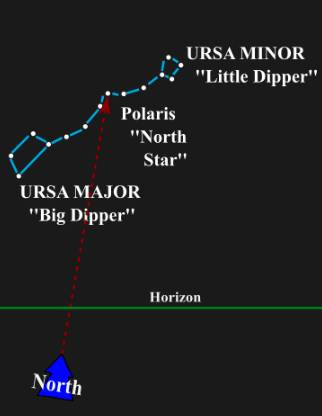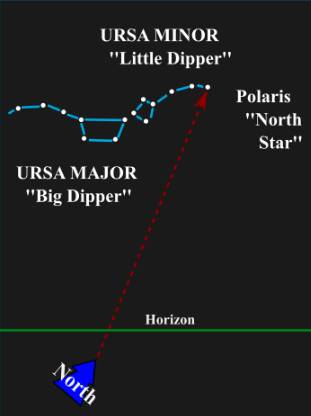
(a)
The sketch showing how Polaris, the Little Dipper and the Big Dipper would appear at
Explanation of Solution
Introduction:
It is known that the Earth rotates from West to East. One complete rotation around its axis is completed by Earth in
Earth rotates by
The time difference between
Therefore, the angle covered by the Earth around its axis within this time period of
Thus, at
The following figure shows the sketch showing how Polaris, the Little Dipper and the Big Dipper would appear at

Figure (1)
Conclusion:
Therefore, Figure (1) shows the sketch of how the Polaris, the Little Dipper and the Big Dipper would appear at
(b)
The sketch showing how Polaris, the Little Dipper and the Big Dipper would appear at
Explanation of Solution
Introduction:
It is known that the Earth rotates from West to East. One complete rotation around its axis is completed by Earth in
Earth rotates by
The time difference between
Therefore, the angle covered by the Earth around its axis within this time period of
Thus, at
The following figure shows the sketch showing how Polaris, the Little Dipper and the Big Dipper would appear at

Figure (2)
Conclusion:
Therefore, Figure (2) shows the sketch of how the Polaris, the Little Dipper and the Big Dipper would appear at
Want to see more full solutions like this?
Chapter 2 Solutions
Universe: Stars And Galaxies
- On the day of the vernal equinox, the day length for all places on Earth is actually slightly longer than 12 hours. Explain why.arrow_forwardI am trying to plot the ground tracks of an orbit. But I am having a problem with finding the longitude. The equation for the longitude is shown in the image. Is the Theta GMST initially zero because the greenwich meridian points to the Aries point (x-axis). How do you calculate alpha or vernal equinox? I saw a formula for alpha which is alpha = arctan(ry/rx), but the formula was for Right Ascension angle. Is the right ascension angle the same as vernal equinox. If not, then what is the formula for vernal equinox.arrow_forwardIf you go on vacation down to the Florida Keys, the North Star (aka Polaris) located near the North Celestial Pole is found at an altitude of approximately 25 degrees above the horizon. Why is it found near that altitude?arrow_forward
- This subject is astronomy-the solar system. How could you use the night sky (constellations) to find north at night? Is this "north" the same as geographic north? Why/why not?arrow_forwardThinking about the Scale of the Solar System As we discussed, the radius of the Earth is approximately 6370 km. The Sun, on the other hand, is approximately 700,000 km in radius and located, on average, one astronomical unit (1 au=1.5x108 km) from the Earth. Imagine that you stand near Mansueto Library, at the corner of 57th and Ellis. You hold a standard desk globe, which has a diameter of 12 inches, and you want to build a model of the Sun, Earth, and their separation that keeps all sizes and lengths in proportion to one another. a) How big would the Sun be in this scale model? Give your answer in feet and meters. b) The nearest star to the Solar System outside of the Sun is Proxima Centauri, which is approximately 4.2 light years away (a light year is the distance light travels in one year, or approximately 9.5x1012 km). Given the scale model outlined above, how far would a model Proxima Centauri be placed from you? Give your answer in miles and km.arrow_forwardIf you go out to look at the night sky tonight from central Iowa, the North Star (aka Polaris) is located near the North Celestial Pole at an altitude of approximately 42 degrees above the horizon. Why is that the case? What is the altitude of the celestial equator at its highest point as viewed from this location and how do we calculate that? Explain the myth behind one of the constellations located near North Celestial Pole and then explain the myth behind another constellation along the ecliptic plane.arrow_forward
- Part 3 1. The diameter of the Sun is 1,391,400 km. The diameter of the Moon is 3,474.8 km. Find the ratio, r= Dsa/Dsvan between the sizes. 2. From the point of view of an obs erver on Eanth (consider the Earth as a point-like object), during the eclipse, the Moon covers the Sun exactly. Sketch a picture to illustrate this fact. Use a nuler to get a straight line. Your drawing does not need to be in scale. 3. The Sun is 1 Astronomical Unit (AU) away from the Earth. Find the distance between the Earth and the Moon in AU's using the ratio of similar triangles. Show your work. DEM= AU. Convert this to kilometers. Use 1 AU = 149,600,000 km. DEM = km.arrow_forwardIs there any place on Earth where all the visible stars are circumpolar? If so, where? Is there any place on Earth where none of the visible stars is circumpolar? If so, where? Explain your answers.arrow_forward- How far (in km) is 3.5 lightyears(ly) – the distance traveled by light in one Earth year? - How much is this same value in parsecs and (C) in astronomical units (AU)? Use 299,732 km/s for the speed of light (c) and 1 year = 365 days. Show your solution and write your answer in both regular notation and scientific notation.arrow_forward

 Stars and GalaxiesPhysicsISBN:9781305120785Author:Michael A. Seeds, Dana BackmanPublisher:Cengage Learning
Stars and GalaxiesPhysicsISBN:9781305120785Author:Michael A. Seeds, Dana BackmanPublisher:Cengage Learning Stars and Galaxies (MindTap Course List)PhysicsISBN:9781337399944Author:Michael A. SeedsPublisher:Cengage Learning
Stars and Galaxies (MindTap Course List)PhysicsISBN:9781337399944Author:Michael A. SeedsPublisher:Cengage Learning
 Foundations of Astronomy (MindTap Course List)PhysicsISBN:9781337399920Author:Michael A. Seeds, Dana BackmanPublisher:Cengage Learning
Foundations of Astronomy (MindTap Course List)PhysicsISBN:9781337399920Author:Michael A. Seeds, Dana BackmanPublisher:Cengage Learning AstronomyPhysicsISBN:9781938168284Author:Andrew Fraknoi; David Morrison; Sidney C. WolffPublisher:OpenStax
AstronomyPhysicsISBN:9781938168284Author:Andrew Fraknoi; David Morrison; Sidney C. WolffPublisher:OpenStax





